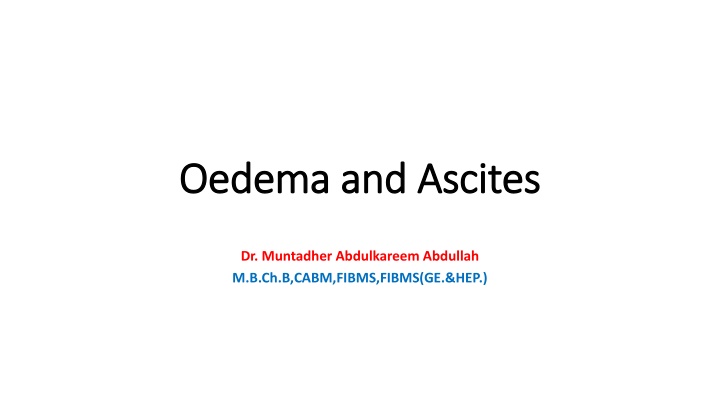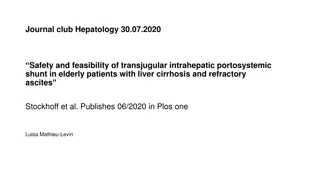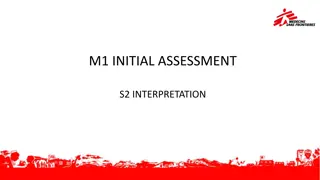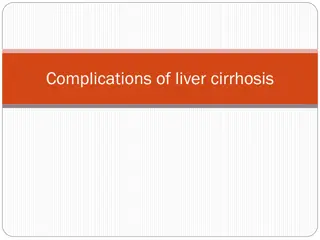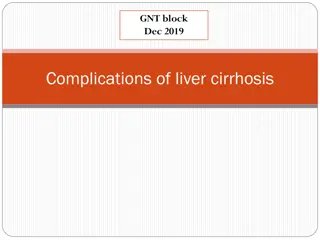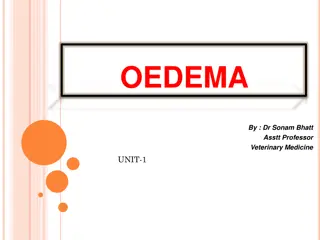Oedema and Ascites
Oedema, characterized by fluid accumulation in tissues, can present as pitting or non-pitting oedema. Learn about its causes, clinical assessment, management strategies, and investigations involved in diagnosing oedema.
Download Presentation

Please find below an Image/Link to download the presentation.
The content on the website is provided AS IS for your information and personal use only. It may not be sold, licensed, or shared on other websites without obtaining consent from the author.If you encounter any issues during the download, it is possible that the publisher has removed the file from their server.
You are allowed to download the files provided on this website for personal or commercial use, subject to the condition that they are used lawfully. All files are the property of their respective owners.
The content on the website is provided AS IS for your information and personal use only. It may not be sold, licensed, or shared on other websites without obtaining consent from the author.
E N D
Presentation Transcript
Oedema and Ascites Oedema and Ascites Dr. Muntadher Abdulkareem Abdullah M.B.Ch.B,CABM,FIBMS,FIBMS(GE.&HEP.)
Oedema Oedema Oedema is caused by an excessive accumulation of fluid within the interstitial space. Clinically, this can be detected by persistence of an indentation in tissue following pressure on the affected area (pitting oedema).
Pitting oedema tends to accumulate in the ankles during the day and improves overnight as the interstitial fluid is reabsorbed. Non-pitting oedema is typical of lymphatic obstruction and may also occur as the result of excessive matrix deposition in tissues:
Clinical assessment : Dependent areas, such as the ankles and lower legs, are typically affected first . oedema can be restricted to the sacrum in bed-bound patients. With increasing severity, oedema spreads to affect the upper parts of the legs, the genitalia and abdomen. Facial oedema on waking is common.
Investigations Investigations Oedema may be due to a number of causes , which are usually apparent from the history and examination of the cardiovascular system and abdomen. Blood should be taken for measurement of urea and electrolytes, liver function and serum albumin, and the urine tested for protein. Further imaging of the liver, heart or kidneys may be indicated, based on history and clinical examination.
Management Mild oedema usually responds to elevation of the legs, compression stockings, or a thiazide or a low dose of a loop diuretic, such as furosemide or bumetanide. In nephrotic syndrome, renal failure and severe cardiac failure, very large doses of diuretics, sometimes in combination, may be required to achieve a negative sodium and fluid balance. Restriction of sodium intake and fluid intake may be required. Diuretics are not helpful in the treatment of oedema caused by venous or lymphatic obstruction or by increased capillary permeability. Specific causes of oedema, such as venous thrombosis, should be treated.
Ascites Ascites Ascites is present when there is accumulation of free fluid in the peritoneal cavity.
Small amounts of ascites are asymptomatic, but with larger accumulations of fluid (>1 L) there is abdominal distension, fullness in the flanks, shifting dullness on percussion and, when the ascites is marked, a fluid thrill/fluid wave. Other features include eversion of the umbilicus, herniae, abdominal striae, divarication of the recti and scrotal oedema. Dilated superficial abdominal veins may be seen if the ascites is due to portal hypertension.
Pathophysiology : Ascites has numerous causes, the most common of which are malignant disease, cirrhosis and heart failure. Many primary disorders of the peritoneum and visceral organs can also cause ascites, and these need to be considered even in a patient with chronic liver disease . Splanchnic vasodilatation is thought to be the main factor leading to ascites in cirrhosis. This is mediated by vasodilators (mainly nitric oxide) that are released when portal hypertension causes shunting of blood into the systemic circulation.
Systemic arterial pressure falls due to pronounced splanchnic vasodilatation as cirrhosis advances. This leads to activation of the renin angiotensin system with secondary aldosteronism, increased sympathetic nervous activity, increased atrial natriuretic hormone secretion and altered activity of the kallikrein kinin system . These systems tend to normalize arterial pressure but produce salt and water retention. In this setting, the combination of splanchnic arterial vasodilatation and portal hypertension alters intestinal capillary permeability, promoting accumulation of fluid within the peritoneum.
Investigations Ultrasonography is the best means of detecting ascites, particularly in the obese and those with small volumes of fluid. Paracentesis (if necessary under ultrasonic guidance) can be used to obtain ascitic fluid for analysis. The appearance of ascitic fluid may point to the underlying cause .Pleural effusions are found in about 10% of patients, usually on the right side (hepatic hydrothorax); most are small and identified only on chest X-ray, but occasionally a massive hydrothorax occurs. Pleural effusions, particularly those on the left side, should not be assumed to be due to the ascites.
Measurement of the protein concentration and the serum ascites albumin gradient (SAAG) can be a useful tool to distinguish ascites of different aetiologies. Cirrhotic patients typically develop ascites with a low protein concentration ( transudate ; protein concentration 30 g/L (3.0 g/dL). In these cases, it is useful to calculate the SAAG by subtracting the concentration of the ascites fluid albumin from the serum albumin. A gradient of >11 g/L (1.1 g/dL) is 96% predictive that ascites is due to portal hypertension. Venous outflow obstruction due to cardiac failure or hepatic venous outflow obstruction can also cause a transudative ascites, as indicated by an albumin gradient of >11 g/L (1.1 g/dL) but, unlike in cirrhosis, the total protein content is usually >25 g/L (2.5 g/dL).
High protein ascites (exudate; protein concentration >25 g/L (2.5 g/dL) or a SAAG of 1000 U/L identifies pancreatic ascites, whereas low ascites glucose concentrations suggest malignant disease or tuberculosis. Cytological examination may reveal malignant cells (one-third of cirrhotic patients with a bloody tap have a hepatocellular carcinoma). Polymorphonuclear leucocyte counts of >250 106 /L strongly suggest infection (spontaneous bacterial peritonitis; see below). Laparoscopy can be valuable in detecting peritoneal disease. The presence of triglyceride at a level >1.1 g/L (110 mg/dL) is diagnostic of chylous ascites and suggests anatomical or functional abnormality of lymphatic drainage from the abdomen. The ascites in this context has a characteristic milky-white appearance.
Management Management Treatment of transudative ascites is based on: restricting sodium and water intake, promoting urine output with diuretics and, if necessary, removing ascites directly by paracentesis. Exudative ascites due to malignancy is treated with paracentesis but fluid replacement is generally not required. During management of ascites, the patient should be weighed regularly. Diuretics should be titrated to remove no more than 1 L of fluid daily, so body weight should not fall by more than 1 kg daily to avoid excessive fluid depletion .
Thanks Thanks
